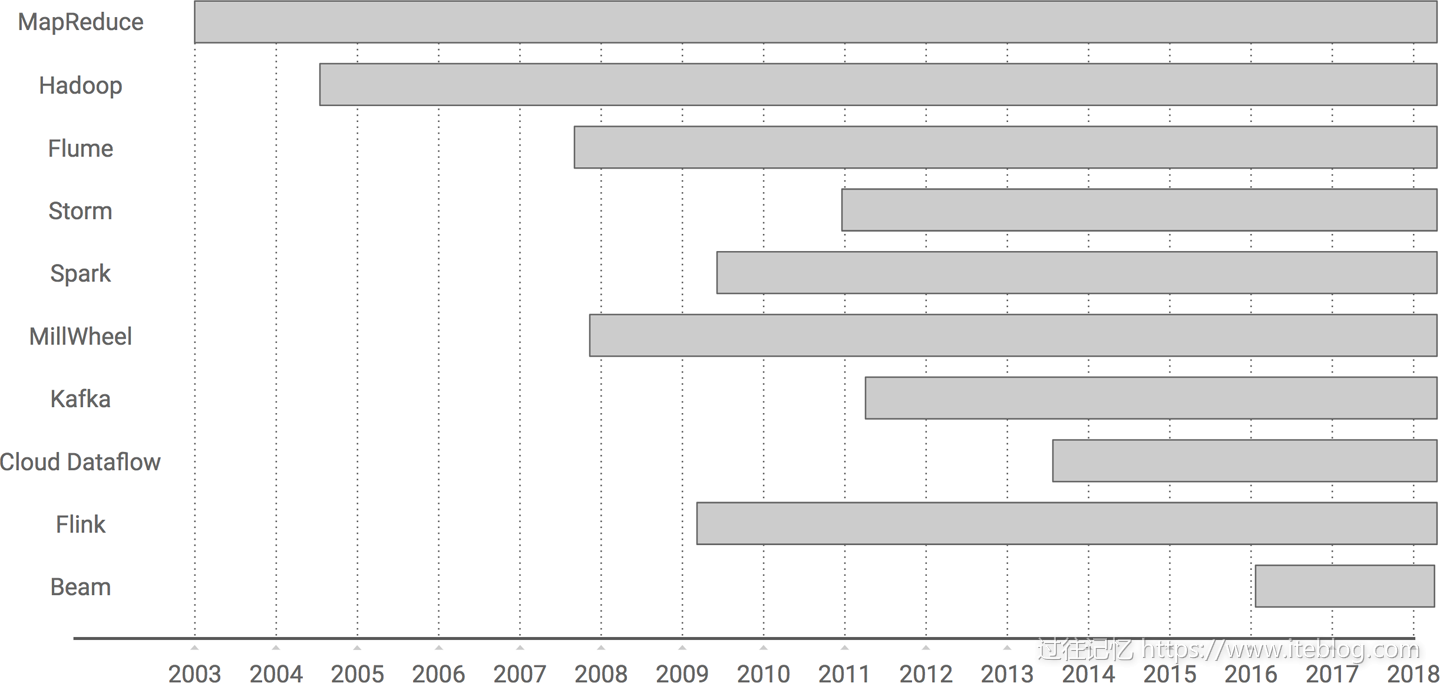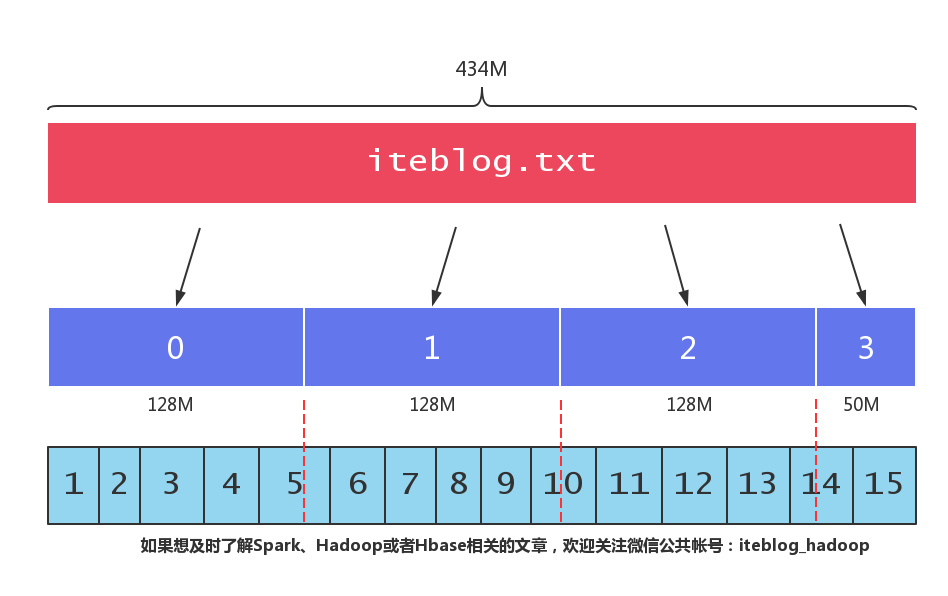我们可能会有些需求要求MapReduce的输出全局有序,这里说的有序是指Key全局有序。但是我们知道,MapReduce默认只是保证同一个分区内的Key是有序的,但是不保证全局有序。基于此,本文提供三种方法来对MapReduce的输出进行全局排序。
生成测试数据
在介绍如何实现之前,我们先来生成一些测试数据,实现如下:
#!/bin/sh
for i in {1..100000};do
echo $RANDOM
done;
将上面的代码保存到 iteblog.sh 的文件里面,然后运行:
$ sh iteblog.sh > data1 $ sh iteblog.sh > data2 $ hadoop fs -put data1 /user/iteblog/input $ hadoop fs -put data2 /user/iteblog/input
$RANDOM 变量是Shell内置的,使用它能够生成五位内的随机正整数。上面我们一共运行了两次,这样我们就有两份随机数文件data1和data2;最后我们把生成的随机数文件上传到HDFS上。现在我们可以来写程序对这两个文件里面的数据进行排序了。
使用一个Reduce进行排序
前面我们说了,MapReduce默认只是保证同一个分区内的Key是有序的,但是不保证全局有序。如果我们将所有的数据全部发送到一个Reduce,那么不就可以实现结果全局有序吗?这种方法实现很简单,如下:
package com.iteblog.mapreduce.sort;
import org.apache.hadoop.conf.Configured;
import org.apache.hadoop.fs.Path;
import org.apache.hadoop.io.IntWritable;
import org.apache.hadoop.io.LongWritable;
import org.apache.hadoop.io.NullWritable;
import org.apache.hadoop.io.Text;
import org.apache.hadoop.mapreduce.Job;
import org.apache.hadoop.mapreduce.Mapper;
import org.apache.hadoop.mapreduce.Reducer;
import org.apache.hadoop.mapreduce.lib.input.FileInputFormat;
import org.apache.hadoop.mapreduce.lib.output.FileOutputFormat;
import org.apache.hadoop.util.Tool;
import org.apache.hadoop.util.ToolRunner;
import java.io.IOException;
public class TotalSortV1 extends Configured implements Tool {
static class SimpleMapper extends
Mapper<LongWritable, Text, IntWritable, IntWritable> {
@Override
protected void map(LongWritable key, Text value,
Context context) throws IOException, InterruptedException {
IntWritable intWritable = new IntWritable(Integer.parseInt(value.toString()));
context.write(intWritable, intWritable);
}
}
static class SimpleReducer extends
Reducer<IntWritable, IntWritable, IntWritable, NullWritable> {
@Override
protected void reduce(IntWritable key, Iterable<IntWritable> values,
Context context) throws IOException, InterruptedException {
for (IntWritable value : values)
context.write(value, NullWritable.get());
}
}
@Override
public int run(String[] args) throws Exception {
if (args.length != 2) {
System.err.println("<input> <output>");
System.exit(127);
}
Job job = Job.getInstance(getConf());
job.setJarByClass(TotalSortV1.class);
FileInputFormat.addInputPath(job, new Path(args[0]));
FileOutputFormat.setOutputPath(job, new Path(args[1]));
job.setMapperClass(SimpleMapper.class);
job.setReducerClass(SimpleReducer.class);
job.setMapOutputKeyClass(IntWritable.class);
job.setMapOutputValueClass(IntWritable.class);
job.setOutputKeyClass(IntWritable.class);
job.setOutputValueClass(NullWritable.class);
job.setNumReduceTasks(1);
job.setJobName("TotalSort");
return job.waitForCompletion(true) ? 0 : 1;
}
public static void main(String[] args) throws Exception {
int exitCode = ToolRunner.run(new TotalSort(), args);
System.exit(exitCode);
}
}
上面程序的实现很简单,我们直接使用 TextInputFormat 类来读取上面生成的随机数文件(data1 和 data2)。因为文件里面的数据是正整数,所以我们在 SimpleMapper 类里面直接将value转换成int类型,然后赋值给IntWritable。等数据到 SimpleReducer 的时候,同一个Reduce里面的Key已经全部有序;因为我们设置了一个Reduce作业,这样的话,我们就实现了数据全局有序。运行如下:
[iteblog@www.iteblog.com /home/iteblog]$ hadoop jar total-sort-0.1.jar com.iteblog.mapreduce.sort.TotalSortV1 /user/iteblog/input /user/iteblog/output [iteblog@www.iteblog.com /home/iteblog]$ hadoop fs -ls /user/iteblog/output Found 2 items -rw-r--r-- 3 iteblog supergroup 0 2017-05-09 11:41 /user/iteblog/output/_SUCCESS -rw-r--r-- 3 iteblog supergroup 1131757 2017-05-09 11:41 /user/iteblog/output/part-r-00000 [iteblog@www.iteblog.com /home/iteblog]$ hadoop fs -cat /user/iteblog/output/part-r-00000 | head -n 10 0 0 0 0 1 1 1 1 1 1 [iteblog@www.iteblog.com /home/iteblog]$ hadoop fs -cat /user/iteblog/output/part-r-00000 | tail -n 10 32766 32766 32766 32766 32767 32767 32767 32767 32767 32767
从上面的测试结果也可以看出,我们只生成了一个数据文件,而且这个文件里面的数据已经全局有序了。
自定义分区函数实现全局有序
上面实现数据全局有序有个很大的局限性:所有的数据都发送到一个Reduce进行排序,这样不能充分利用集群的计算资源,而且在数据量很大的情况下,很有可能会出现OOM问题。我们分析一下,MapReduce默认的分区函数是HashPartitioner,其实现的原理是计算map输出key的 hashCode ,然后对Reduce个数求模,这样只要求模结果一样的Key都会发送到同一个Reduce。如果我们能够实现一个分区函数,使得
- 所有 Key < 10000 的数据都发送到Reduce 0;
- 所有 10000 < Key < 20000 的数据都发送到Reduce 1;
- 其余的Key都发送到Reduce 2;
这就实现了Reduce 0的数据一定全部小于Reduce 1,且Reduce 1的数据全部小于Reduce 2,再加上同一个Reduce里面的数据局部有序,这样就实现了数据的全局有序。实现如下:
package com.iteblog.mapreduce.sort;
import com.iteblog.mapreduce.secondSort.IntPair;
import org.apache.hadoop.conf.Configured;
import org.apache.hadoop.fs.Path;
import org.apache.hadoop.io.IntWritable;
import org.apache.hadoop.io.LongWritable;
import org.apache.hadoop.io.NullWritable;
import org.apache.hadoop.io.Text;
import org.apache.hadoop.mapreduce.Job;
import org.apache.hadoop.mapreduce.Mapper;
import org.apache.hadoop.mapreduce.Partitioner;
import org.apache.hadoop.mapreduce.Reducer;
import org.apache.hadoop.mapreduce.lib.input.FileInputFormat;
import org.apache.hadoop.mapreduce.lib.output.FileOutputFormat;
import org.apache.hadoop.util.Tool;
import org.apache.hadoop.util.ToolRunner;
import java.io.IOException;
public class TotalSortV2 extends Configured implements Tool {
static class SimpleMapper extends Mapper<LongWritable, Text, IntWritable, IntWritable> {
@Override
protected void map(LongWritable key, Text value,
Context context) throws IOException, InterruptedException {
IntWritable intWritable = new IntWritable(Integer.parseInt(value.toString()));
context.write(intWritable, intWritable);
}
}
static class SimpleReducer extends Reducer<IntWritable, IntWritable, IntWritable, NullWritable> {
@Override
protected void reduce(IntWritable key, Iterable<IntWritable> values,
Context context) throws IOException, InterruptedException {
for (IntWritable value : values)
context.write(value, NullWritable.get());
}
}
public static class IteblogPartitioner extends Partitioner<IntWritable, IntWritable> {
@Override
public int getPartition(IntWritable key, IntWritable value, int numPartitions) {
int keyInt = Integer.parseInt(key.toString());
if (keyInt < 10000) {
return 0;
} else if (keyInt < 20000) {
return 1;
} else {
return 2;
}
}
}
@Override
public int run(String[] args) throws Exception {
if (args.length != 2) {
System.err.println("<input> <output>");
System.exit(127);
}
Job job = Job.getInstance(getConf());
job.setJarByClass(TotalSortV2.class);
FileInputFormat.addInputPath(job, new Path(args[0]));
FileOutputFormat.setOutputPath(job, new Path(args[1]));
job.setMapperClass(SimpleMapper.class);
job.setReducerClass(SimpleReducer.class);
job.setPartitionerClass(IteblogPartitioner.class);
job.setMapOutputKeyClass(IntWritable.class);
job.setMapOutputValueClass(IntWritable.class);
job.setOutputKeyClass(IntWritable.class);
job.setOutputValueClass(NullWritable.class);
job.setNumReduceTasks(3);
job.setJobName("dw_subject");
return job.waitForCompletion(true) ? 0 : 1;
}
public static void main(String[] args) throws Exception {
int exitCode = ToolRunner.run(new TotalSortV2(), args);
System.exit(exitCode);
}
}
第二版的排序实现除了自定义的 IteblogPartitioner,其余的和第一种实现一样。现在我们来运行一下:
[iteblog@www.iteblog.com /home/iteblog]$ hadoop jar total-sort-0.1.jar com.iteblog.mapreduce.sort.TotalSortV2 /user/iteblog/input /user/iteblog/output1 [iteblog@www.iteblog.com /home/iteblog]$ hadoop fs -ls /user/iteblog/output1 Found 4 items -rw-r--r-- 3 iteblog supergroup 0 2017-05-09 13:53 /user/iteblog/output1/_SUCCESS -rw-r--r-- 3 iteblog supergroup 299845 2017-05-09 13:53 /user/iteblog/output1/part-r-00000 -rw-r--r-- 3 iteblog supergroup 365190 2017-05-09 13:53 /user/iteblog/output1/part-r-00001 -rw-r--r-- 3 iteblog supergroup 466722 2017-05-09 13:53 /user/iteblog/output1/part-r-00002 [iteblog@www.iteblog.com /home/iteblog]$ hadoop fs -cat /user/iteblog/output1/part-r-00000 | head -n 10 0 0 0 0 1 1 1 1 1 1 [iteblog@www.iteblog.com /home/iteblog]$ hadoop fs -cat /user/iteblog/output1/part-r-00000 | tail -n 10 9998 9998 9998 9999 9999 9999 9999 9999 9999 9999 [iteblog@www.iteblog.com /home/iteblog]$ hadoop fs -cat /user/iteblog/output1/part-r-00001 | head -n 10 10000 10000 10000 10000 10000 10000 10001 10001 10001 10001 [iteblog@www.iteblog.com /home/iteblog]$ hadoop fs -cat /user/iteblog/output1/part-r-00001 | tail -n 10 19997 19997 19998 19998 19998 19998 19999 19999 19999 19999 [iteblog@www.iteblog.com /home/iteblog]$ hadoop fs -cat /user/iteblog/output1/part-r-00002 | head -n 10 20000 20000 20000 20000 20000 20000 20001 20001 20001 20001 [iteblog@www.iteblog.com /home/iteblog]$ hadoop fs -cat /user/iteblog/output1/part-r-00002 | tail -n 10 32766 32766 32766 32766 32767 32767 32767 32767 32767 32767
我们已经看到了这个程序生成了三个文件(因为我们设置了Reduce个数为3),而且每个文件都是局部有序;所有小于10000的数据都在part-r-00000里面,所有小于20000的数据都在part-r-00001里面,所有大于20000的数据都在part-r-00002里面。part-r-00000、part-r-00001和part-r-00002三个文件实现了全局有序。
这个方法也实现了数据的全局有序,但是也有一些问题,明天我再写一篇文章介绍第三种数据全局排序的方法。
本博客文章除特别声明,全部都是原创!原创文章版权归过往记忆大数据(过往记忆)所有,未经许可不得转载。
本文链接: 【三种方法实现Hadoop(MapReduce)全局排序(1)】(https://www.iteblog.com/archives/2146.html)








